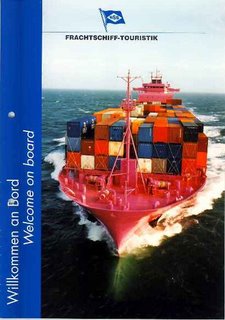
After many years of hard work, study, and self-sacrifice it is appropriate that I take some personal time—time to seek new horizons, new adventures, and new opportunities. So, I have decided to visit exotic Asia, and to get there I am using a traditional, but now neglected, means of travel—a freighter! As you can see I have a big, pink ship ready to transport me from Perth to Singapore.
Long distance travel these days in predominantly by aeroplane, with rail and cruise ship coming in second and third. This does raise the question as to why I decided to travel on a freighter. The answer is that it is about the journey, not the destination. A plane is a few hours in a crowded tin can, by which means one reaches one’s destination separated physically from one’s point of origin, but not always psychologically. A cruise ship is a long party, with distraction and frivolity, characteristics far from undesirable, but those which do not fit my present mood or desire.
The ship I will be travelling on is the ANL Espirit. It is a 34,000 tonne freighter, built (I am glad to say) in 1998, making it is less than a decade old. It is not huge as freighters go, but definitely big, it is 208 metres long and 30 wide. The crew is predominately German, with some Philippinoes. As far as I can gather this ship, and its sister ships, spend their days circling southern Australia and then heading north to Singapore and Malaysia, loading and unloading their cargo as circumstances require. An interesting life. I decided to reserve the owner’s cabin, this is the ‘best’ passenger cabin on board, but the price differential is not great.
I leave Fremantle on the 6th of June for an 8 day journey. The onboard accommodation is comfortable, but a freighter is not packed with 5 star restaurants and casinos. There are a few luxuries, a pool and a small gym, but travel on a freighter offers a different choice from both air and cruise ship travel. It is more contemplative, restful, and quiet, it is a chance to spend some time with oneself. As the day approachs I find I am growing increasingly eager to embark.
Once I am in Singapore I plan to spend a week or so there, after which I will travel to Thailand and Bangkok via train. This is a 2 day journey, with the option of a few stopovers (which I will take). Once in Thailand I may stay a while, or I may travel further. I would like to visit Vietnam and Cambodia, and maybe other countries in the region.
Check back here to find out how I am progressing.
All the best to all.
Comments